Building your marketing strategy or marketing plan doesn’t have to be tedious. It takes some work, but hopefully, this post will give you the resources to focus on the work and not the process or tools.
Solopreneurs go ahead and dive right in! If you are part of a marketing team or a startup, we definitely recommend making this a group effort. Get out a whiteboard or stacks of sticky notes, order some pizza, and make it fun.
Each of these 5 steps must be completed in order. They start high-level and then drill down. At the end of the exercise, you will have a marketing plan that is ready to go. We have created some templates and an example brand to help you follow along and create your own integrated marketing strategy.
To help you along, we’ve developed some templates you can print out. Here is a link to the form to get the free downloads. Yes, we ask for your email. No, we won’t abuse it or try to sell you anything.
Sorry for the interruption, back to our regularly scheduled post. Here is an overview of the 5 steps:
- Define your high-level Brand Strategy
- Define your Target Audiences
- Build a Profile for each audience
- Build a Marketing Strategy
- Define some tactics and get started!
Define your high-level brand strategy
Consumers are looking for an authentic brand experience. One of the ways brands resonate with consumers is when there is a shared value. Think of brands that you connect with. There is usually something more than just a product or service that drives that connection.
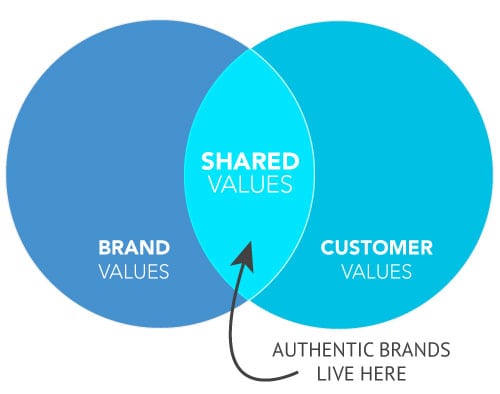
For example, I am a big fan of Miir. Not only do they sell great gear, but they provide clean water to people around the world with every purchase. We have a shared value which is we both value social justice and serving the other. So when I buy from them, I feel that I am getting a product I need AND helping contribute.
To have a shared value with your customers, you will need to know what your own values are. That is why defining your high-level brand or business strategy is so important. Your Brand Strategy should include:
1. A mission statement
A mission statement that defines what your brand stands for. This type of thing is covered elsewhere on the net. If you need a primer, here is a good place to start: How to write a powerful mission statement that resonates.
For the sake of this post, we have created a brand called “Sweet Hang” who makes hammocks. The mission statement for Sweet Hangs is “We encourage people to spend more time outdoors by offering high quality hammocks hand made by refugees in Uganda.”
The mission statement should answer “What does your brand do and/or why do you do it?”
2. Brand values
The brand values are those squishier statements that speak more to the “soul” of your brand, product, or service. At Firebrand Creative, we like to put the values before objectives but it is done both ways. The reason we like to put the values first is that it’s more “authentic” for your objective to help accomplish your value than the other way around. When objectives come before values, you get politicians. 😉
For Sweet Hang, we’ve decided on the following values:
- Quality gear lasts forever
- All people deserve a living wage
- Being outdoors increases quality of life
These are the values that will eventually overlap into a shared value with the customer.
Brand values should answer the question “What does our brand stand for or believe in?”
3. Brand objectives
Now we need to list out 2-4 brand or business objectives. Each of these should have a single focus. They are goals that the brand or company wants to see come to fruition.
For Sweet Hangs™, there are three brand objectives.
- Sell hammocks
- Hire over 100 refugee hammock makers
- Become Outdoor Magazine’s readers choice
Whereas the mission may have some aspirational components, the objectives should be attainable even if it’s a stretch to do so. The objectives should be measurable. You need to be able to tell when you are accomplishing them.
Brand Objectives should line up with your brand values. In this case, you can see that the value “all people deserve a living wage” flows into the “hire 100 refugee hammock makers” objective.
The objectives should answer “What do we want our brand to accomplish?”
4. Elevator Pitch
You might have heard this phrase before. It’s called the elevator pitch because it should be your brand promise, short enough to be delivered to someone in between floors on an elevator. Not that anyone would dare talk on an elevator…
In one to two sentences, what do you want a potential investor or customer to know? For Sweet Hang, we’ve come up with the elevator pitch below:
“Sweet Hang designs the most comfortable, durable, and easy to hang hammocks that help provide trade skills and a living wage to refugees in Uganda.”
If you have more time in the elevator, you can go deeper, but this simple sentence captures what your brand does and invites further questions.
When you are done, the template will look like the image below. Make sure to download the brand strategy templates to help guide you as we move on to the next step: defining your target audience.
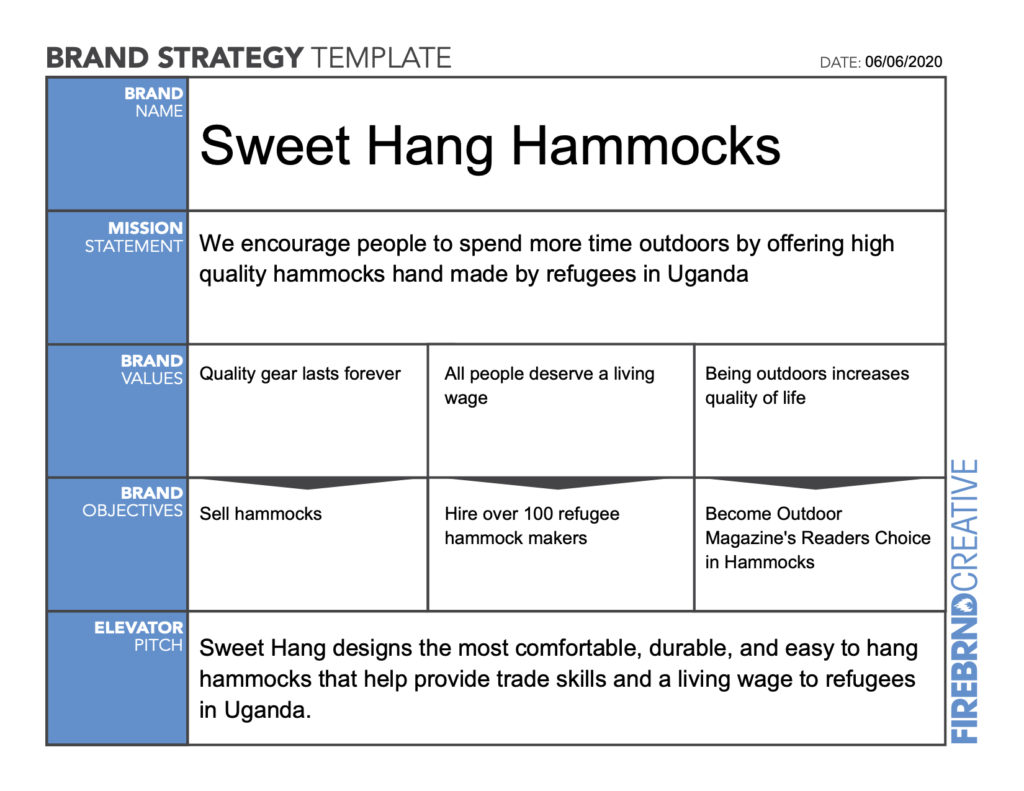
Define your Target Audiences
Marketing books are filled with ways to discover who your target audience is. There are many methods and tricks to getting the target audience perfect. But since we promised an easy-ish (emphasis on the ish) marketing strategy, let’s just stick to some simpler ways to get there. These may change or adapt over time, so revisit them if you feel they need some tweaking.
At this stage, we are broadly defining the audience. What groups are likely to use your product? Let’s look at the Sweet Hang audiences to get the idea.
- Male and female camping enthusiasts aged 24-36
- Males aged 28-50 who enjoy hanging out in the back yard
- Male and female young adults who travel internationally
Notice that each has a gender profile, an age range, and some kind of affinity. Those aren’t hard and fast rules, but they do help narrow down the audience. Does this mean we won’t sell to a camping enthusiast who is 38? Absolutely not. But by targeting this core audience, we will also capture people who are adjacent in one way or another. Maybe they are in a different age range but they feel young or maybe people who love fishing and camp every once in a while.
Defining the target audience in this way gives us smaller chunks to work with when it comes to outlining their values.
What are the goals of our first target audience?
Start to look at places these customers might be present. Start with a known “hub” like Outdoor Magazine in Sweet Hang’s case. See what the articles are about, then look at their social media and explore some hashtags. Pretty soon you will start to see some of the goals rise to the surface. Chances are you have a pretty good handle on their goals to start.
In our case, we found that the first target audience wants to explore remote places and experience nature.
Where is the target audience active?
For the last part of the Target Audiences, make a note of where you can find this audience. This is not an exhaustive list but the top 3-5 locations they frequent. Take a look at our post on defining your target to read about 7-11-4 and the importance of knowing where your customers are.
Our audience frequents Instagram, Outdoor Magazine, YouTube and outdoor blogs. We’ll add that to our Target Audiences Template below and move to building a profile for the audience.
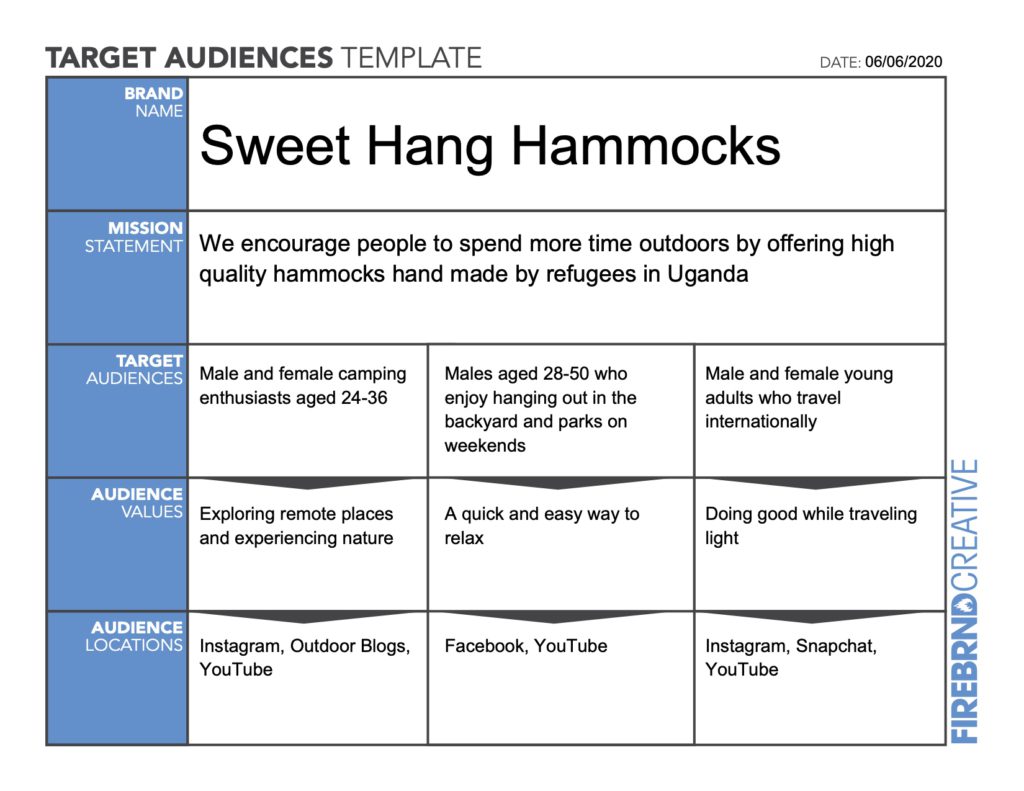
Build a profile for each audience
Still with us? Let’s dive a bit deeper into each of the target audiences. This is where we start to see the development of a strategy that we can act on.
One of our audiences is defined as 24-36 year old male and female camping enthusiasts. We know that one of their goals is to explore remote places and experience nature.
Great. Now, what are OUR brand goals as they pertain to this target audience? List 2-3 goals here that should line up with the Brand Objectives from the Brand Strategy Template. These can (and should) include goals like selling product but also think about objectives that may work together to create more sales.
In our case, growing our YouTube subscriber list and Instagram followers will help us reach the goal of selling hammocks. So we will put all three down. We’re using Instagram and YouTube because we know that is one of the locations our audience frequents.
Authentic brands have shared values with their customers. What are the shared values both you and the customer hold that will help you sell products? One of the things our audience values is dependable, light gear. That lines up great with our brand value of making high-quality hammocks. We’ll go with that.
One of the tools that Firebrand Creative uses to help brands remember the key aspects of a marketing plan is CAMPAV (no relation to Sweet Hangs, we assure you). CAMPAV stands for a Consistent and Measurable Presence that Adds Value. More on CAMPAV can be found on our post here but I want to focus on the measurable part.
The measure of success aka Key Performance Indicators aka KPIs
Our goals must be measurable. Put a number on it. A number is how we know we are doing things right or need to tweak the plan.
To reach our goal of selling hammocks, we need some indicator of our progress towards that goal. This is called the KPI or Key Performance Indicator. For selling products it’s easy, the KPI is the number sold.
But a KPI with no measure is not a goal. So we’ll attach a number and say we want to sell 5000 Sweet Hang Hammocks in 6 months.
You will have one of these sheets for each of the target profiles. It’s not uncommon to have a few “personas” in the binder.
Now we understand who our customer is, what they like and what they value. We’ve seen where they hang out. And lastly, we know what our own goals are and how to know we are doing well. Below is the template filled out with the profile information.
But what do we do to achieve those numbers? That is where the marketing strategy comes in.
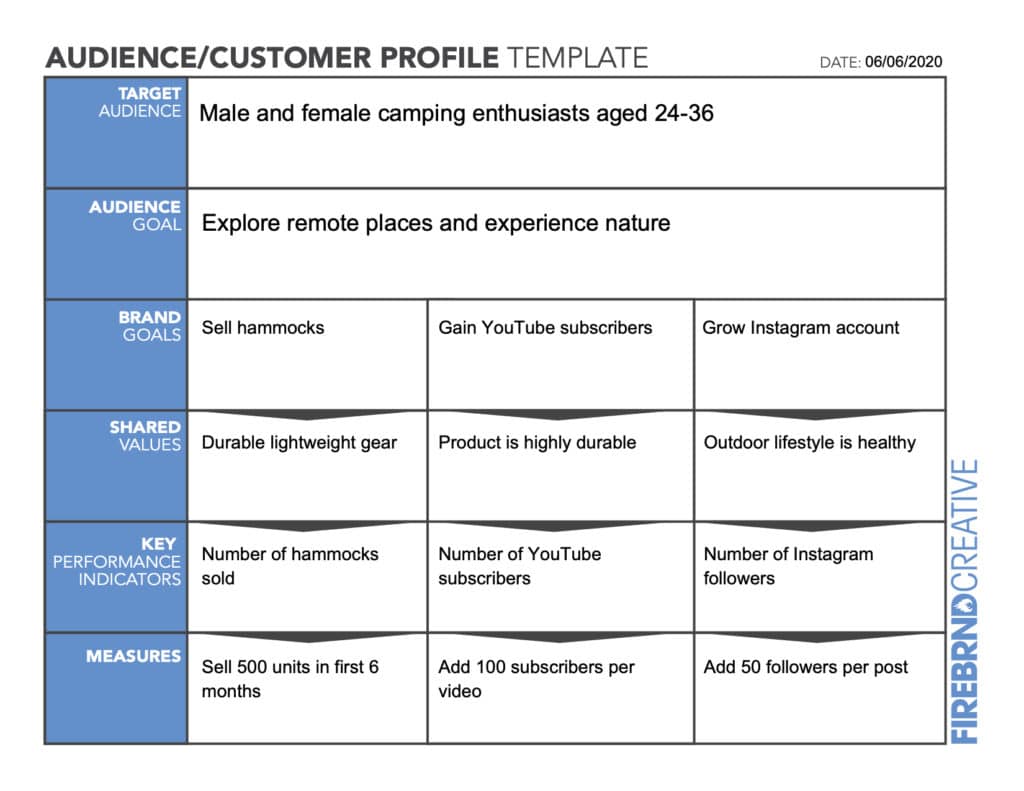
Build a marketing strategy
Your strategy is your roadmap to your destination. It is HOW you will get there. It’s not the details of the day to day (yet, those will come later), but the overarching “what we are gonna do”.
Looking at the Marketing Strategy Template, we carry over the brand goal and target audience from the previous sheet. Then the Channel or Location are 3-4 locations from the previous form.
The next three sections need a little explaining. We have paid efforts, earned efforts, and owned efforts listed. What the heck are those? Can’t we just put in the things we have to do?
Paid Efforts
Paid efforts are things that you will pay for (didn’t see that coming did you?). This would be paid search, google ads, social media ads, etc. Things that cost you money.
Earned Efforts
Earned efforts are shares, reviews, and reposts. Things that you “earn” on account of a great product or engaging post. Earned efforts are those kinds of efforts others do on your behalf. That doesn’t mean that you wait for it to happen though. Actively finding reviewers and encouraging reposts would fit into this.
Owned Efforts
Lastly, owned efforts are those things you have full control of and come from a location you or your brand owns. A post to Instagram, publishing a blog, launching a podcast, these are all earned efforts.
Many efforts will have multiple categories, such as a review where you send free product. That is in the gray area between paid and earned. A great marketing strategy will have a good mix of paid, earned, and owned efforts.
Back to the Marketing Strategy
Looking at the Instagram section of our Marketing Strategy we have filled out each of the three “efforts”. In paid, we will run advertising on Instagram. In earned, we will run a contest on Instagram to win free hammocks. And in owned efforts, we will post 5x a week.
Each of the Locations will have some of the efforts below it. If something doesn’t make sense for the brand, it is fine to leave it blank. For example, maybe you don’t plan to put effort into people tweeting your blog, you can leave earned efforts under blog empty.
Again, each of the Target Audiences will have their own template filled out here. If you have three target audiences, you will have three templates filled out.
At this point, you have a pretty clear marketing strategy. We’ve added the marketing strategy to the template. The next and final step is to develop tactics that you can assign to accomplish the strategy.
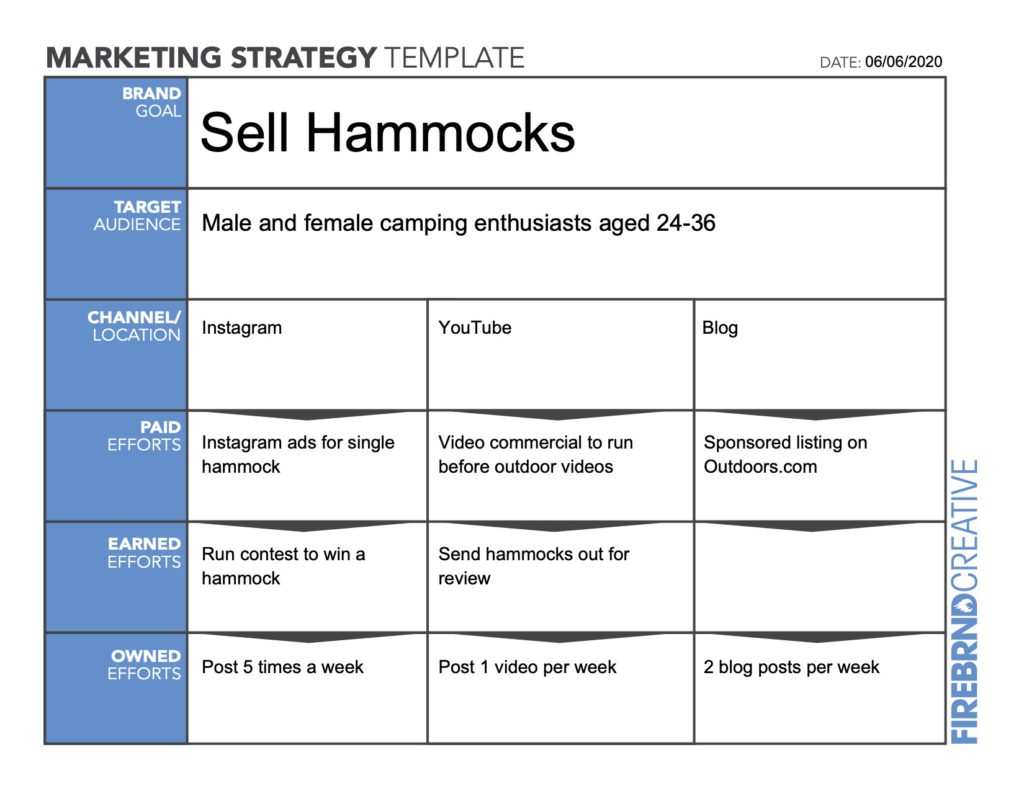
Add some tactics to the marketing strategy and get started!
Every organization is different so we won’t spend too much time here. We recommend taking each effort in the Marketing Strategy template and breaking it down into smaller tasks that can be assigned a due date (or recurring date is better) and a resource to accomplish it.
In our plan we have Instagram Ads in our paid efforts square. To do that we will need:
- The creative of the post
- The text of the post
- Hashtags for the post
- Link for the post
- Landing page for the link
- Posting of the Post
- Monitoring the post for effectiveness
- Answering comments in the post
Each of these things should have a deadline and be assigned to someone who can accomplish them. It may be all one person, or it may be many, but each part needs to be defined.
Go through the list of efforts, break down what each effort will require and then task someone to do them.
That’s it. Maybe it’s not easy, but with the sample templates and descriptions above, it should be easy-ish.
Remember, this is stuff that you might usually hire an agency to do. An agency like Firebrand Creative has decades of experience building these plans. It’s ok to feel a bit overwhelmed. Take it one step at a time and pace yourself. Be willing and reach to change tactics if they are not working.
Please make sure you give each effort time. Growing an Instagram following organically is not a quick process. There are no shortcuts other than authentic content that resonates with customers and is consistently posted.
Now go out and “make a statement that sticks.”
RECOMMENDED NEXT POST
The Customer Journey – Putting People Before Process
